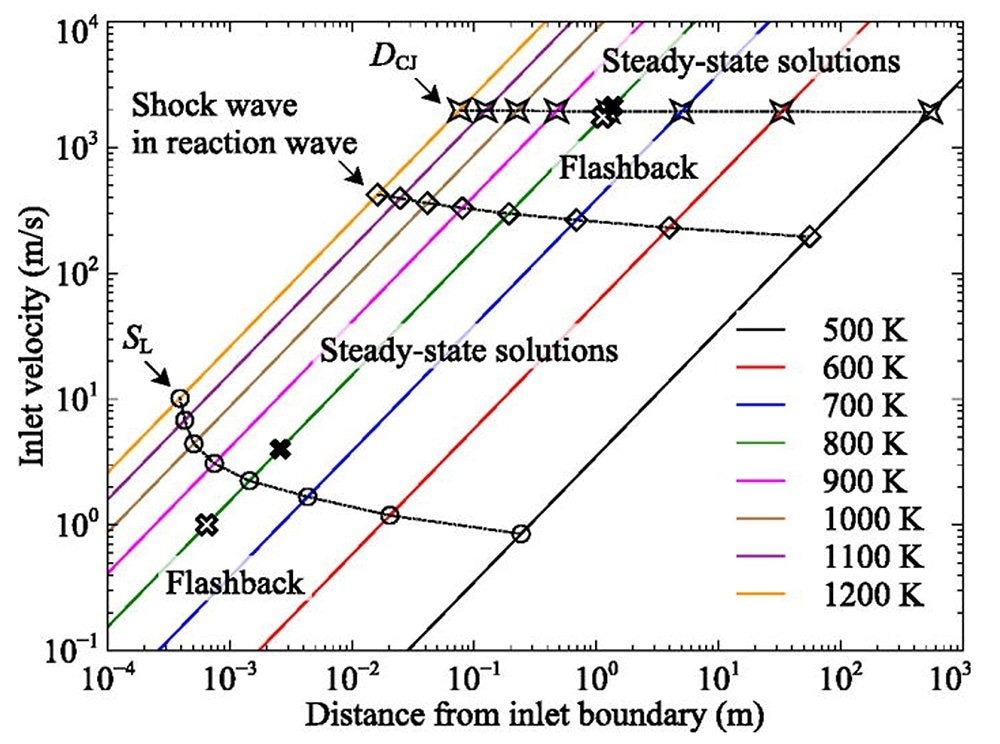Reviewed by Lexie CornerMar 15 2024
Researchers from Tohoku University theoretically established a connection between ignition and deflagration in a combustion system, opening up new possibilities for stable, effective combustion engine configurations because a multitude of steady-state solutions may exist. The research was published in the journal Physics of Fluids.
 The relationships between distance from inlet boundary and inlet velocity for stoichiometric methane-air mixtures. The open circle-shaped markers mean that the inlet velocity is the same as the velocity of the deflagration wave. The open star-shaped markers mean that the inlet velocity is the same as the velocity of the detonation wave. The open diamond-shaped markers mean that the velocity can exceed the speed of sound within the reaction wave when the inlet velocity is subsonic. Image Credit: Youhi Morii
The relationships between distance from inlet boundary and inlet velocity for stoichiometric methane-air mixtures. The open circle-shaped markers mean that the inlet velocity is the same as the velocity of the deflagration wave. The open star-shaped markers mean that the inlet velocity is the same as the velocity of the detonation wave. The open diamond-shaped markers mean that the velocity can exceed the speed of sound within the reaction wave when the inlet velocity is subsonic. Image Credit: Youhi Morii
This research directly tackles the challenge of reducing carbon dioxide emissions by enhancing the efficiency of combustion engines, a significant source of these emissions.
Youhi Mori, Institute of Fluid Science, Tohoku University
Kaoru Maruta, also from the Institute of Fluid Science, said, “A better understanding of combustion dynamics will also support the development of safer, more sustainable engineering solutions.”
Chemical and fluid reactions are intricately coupled in combustion dynamics. Computational fluid dynamics is a tool used by researchers to better comprehend and manage the process.
The structure and control of combustors would be simpler if a system that can function steadily in a steady state and has a certain tolerance range for minor perturbations could be used. This would also raise the possibility of commercializing new combustor designs.
To investigate this idea, Tohoku University researchers looked at a straightforward, one-dimensional reactive flow system in which burned gas, or deflagration wave, exits from the right outlet boundary and unburned premixed gas enters a combustion chamber from the left inlet boundary.
Until now, the working theory maintained that a steady-state solution could only occur when the inlet velocity matched the velocity of the detonation wave, a shock reaction in which the flames exiting travel at supersonic speeds, or the deflagration wave's subsonic velocity.
This conventional wisdom, however, is based on the erroneous belief that no significant chemical reactions are occurring in the preheating zone. Current research highlights the importance of “autoignition-assisted flames,” in which chemical reactions occurring before the flame help a deflagration propagating in a hot, unburned premixed gas mixture to spread more quickly.
This implies that there are a variety of steady-state solutions that influence how long the gas remains in residence before deflagration.
Based on these results, the researchers at Tohoku University developed a theory that effectively bridged the gap between deflagration and ignition waves. This theory revealed the existence of additional steady-state solutions that could be reached if the “autoignitive reaction wave,” a wave that exhibits deflagration-like behavior but is influenced by ignition in the preheat zone, is taken into consideration.
Contrary to the prevailing view that only a single steady-state solution exists for deflagration waves in subsonic one-dimensional systems, our approach posits an infinite number of such solutions as autoignitive reaction waves, asserting that ignition and flame are intrinsically linked.
Youhi Mori, Institute of Fluid Science, Tohoku University
This indicates that steady-state solutions exist, if autoignitive conditions are considered, not only at the two points where the inlet velocity matches the velocities of the deflagration or detonation waves but also in a wider region.
The team further expanded the theory to include situations with supersonic inlet velocities. The conventional understanding is that a steady-state solution can only occur when the detonation wave and inlet velocity are equal. Nonetheless, the researchers contended that the autoignitive reaction wave ought to be unaffected by the inlet velocity because it results from zero-dimensional ignition.
Morii said, “We propose that an infinite number of steady-state solutions exist for the autoignitive reaction wave, even in supersonic conditions.”
This theoretical connection between flame and ignition opens up new ways of looking at engines. Taking into account ignition phenomena makes it possible for combustion to be more stable, which inspires the idea of a novel engine concept that is more efficient than the traditional one.
This work on stabilizing autoignitive reaction waves marks a fundamental breakthrough, potentially revolutionizing the design of combustion systems, especially in the realm of supersonic combustion.
Youhi Mori, Institute of Fluid Science, Tohoku University
Although the new engine concept has been developed through theoretical and numerical results, it has not yet been confirmed through experimentation. As a result, the group intends to use collaborative research and additional experimental verification to apply the study findings to a real engine.
Journal Reference:
Morii, Y., et al. (2024) General concept for autoignitive reaction wave covering from subsonic to supersonic regimes. Physics of Fluids. doi.org/10.1063/5.0176262